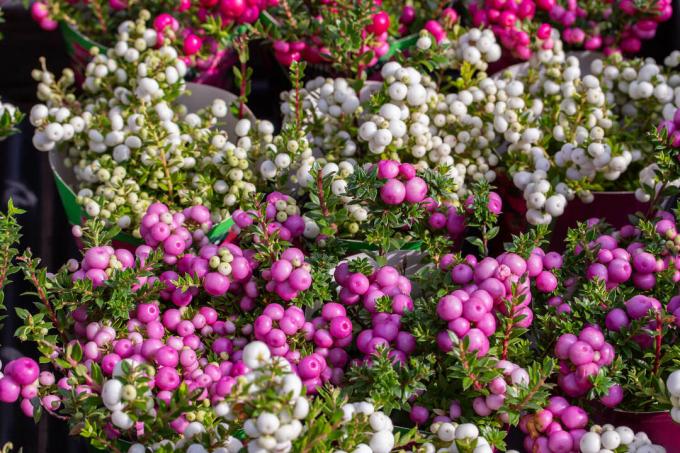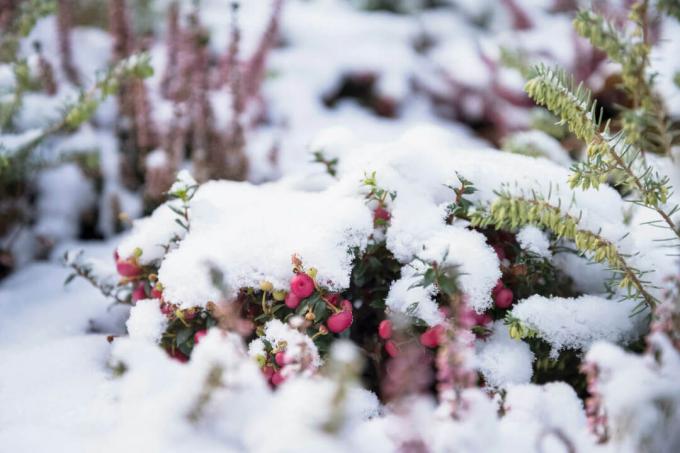The peat myrtle with its eye-catching berries thrives particularly well on acidic soil. Their white bell-shaped flowers and colorful berries are an eye-catcher, especially in winter.

The evergreen peat myrtle (Gaultheria mucronata) is an eye-catcher in every garden in autumn with its small white to red colored berries. However, there are a few special features that should be considered when planting and caring for the ericaceous plant.
contents
- Peat myrtle: origin and properties
- The most beautiful peat myrtle varieties
- Plants: location, timing and procedure
- Care of peat myrtle
- Hibernation: Is the peat myrtle hardy?
- Is peat myrtle poisonous?
Peat myrtle: origin and properties
The peat myrtle, also known as the stinging cloudberry, is a plant from the heather family (Ericaceae). The botanical name of the plant is Gaultheria mucronata, but also the now no longer valid name Pernettya mucronata is still common. The peat myrtle originally comes from moorland in southern Chile and Argentina. It is an evergreen subshrub with small, dark green, shiny leaves that have a prickly tip. The plants spread in a creeping manner and grow to about a meter in height and width. In summer, from May to June, many white bell-like flowers develop on the perennial plants, which grow into small berries in the course of autumn. Depending on the variety, the berries can be white, pink, purple or red in color. Peat Myrtle is a dioecious plant - meaning there are male and female plants. However, the conspicuous berries only appear on the female plants. Their flowers have a long pistil in the center. In order for the berries to develop, however, they need at least one male plant nearby to provide the necessary pollen.

Tip: In botany, it is customary for the scientist who first discovers a new plant to be able to name it. at Pernettya mucronata and Gaultheria mucronata it has long been assumed that these are closely related, but do not belong to the same genus. However, more recent studies show that the two terms describe the same plant. Gaultheria mucronata was the first valid name and is therefore the recognized name for peat myrtle today. In the trade you can sometimes still find the plant under the old name.
The most beautiful peat myrtle varieties
The commercially available varieties usually hardly differ in their growth habit. Only the color and shape of the berries differ. The following varieties cover a large color spectrum:
- Gaultheria mucronata ‘Mulberry Wine’: This variety bears large, round berries that are pink to dark pink in color.
- Gaultheria mucronata ‘Snow White’: As the name suggests, the berries of this peat myrtle variety are white and slightly indented.
- Gaultheria mucronata 'Signal': The berries can develop a strong signal red.

Plants: location, timing and procedure
The peat myrtle belongs to the heather family and, like other bog plants, grows in moist soil and in an acidic environment. The soil should be permeable in the underground so that no waterlogging forms. If the pH of your garden soil is neutral or even alkaline, it is advisable to replace a generous portion of the soil with acidic soil. Our Plantura Organic Acid Soil With a pH value of 4.6 to 5.4, it is a good basis for heather plants of all kinds. A semi-shady place in the garden is suitable as a location. Potted myrtles grow best when planted in late spring - April to May. Then they can develop a certain hardiness by winter and have better conditions to survive heavy frost. In garden centers and in retail, the plants can usually only be found in autumn, but professional tree nurseries and perennial nurseries offer the plants all year round. When planting the peat myrtle, proceed as follows:
- Time: May – August
- Planting hole at least twice as big as the root ball
- Pour in acidic soil and mix well with existing soil
- Create a swampy mass with plenty of water so that the acidic substrate can soak up water
- Unpot peat myrtle and loosen root balls
- Insert flush with the ground and fill with soil until the plant is firm
- Model the watering edge and cover the ground with mulch material such as bark mulch or pine bark
- In the coming weeks keep the soil well moist until the peat myrtle has established itself
You can also plant peat myrtle in tubs. In this case, you should make sure to use an acidic soil as a base. A drainage layer can also prevent waterlogging in the pot. The bucket is placed in a semi-shady place. The soil should be kept sufficiently moist. The tubs are overwintered in a cool but frost-free place.

Care of peat myrtle
Make sure the soil around the peat myrtle is constantly moist as it is a bog plant. The irrigation water should always be lime-free. Because the plants are very sensitive to lime. Collected rainwater is best. It makes sense to occasionally work peat or acidic soil into the surrounding soil, as the peat myrtle develops broadly and also benefits from acidic soil there. The plants do not need pruning, but annoying shoots can be removed without hesitation. However, an occasional pruning promotes fruiting. If you want to keep the peat myrtle in the garden for several years, it is advisable to fertilize the plants in spring. Acidic liquid fertilizers or long-term fertilizers like ours are suitable for fertilizing Plantura organic hydrangea fertilizer. This supplies all plants that prefer an acidic environment with all the necessary nutrients and acidifies the soil.
Hibernation: Is the peat myrtle hardy?
Young plants must be protected in winter in any case. Cover them with fir branches in winter. In severe frosts, an extra layer of straw or leaves can help. If a peat myrtle is several years old, the plant gets a certain winter hardiness. The plants can withstand temperatures between -15 and -17 °C, but the berries are damaged in severe frost, which reduces the ornamental value. If you have a peat myrtle in a pot, it must be protected from frost over the winter. If possible, the plant should also get light during this time. In spring the plants can be moved back to a shady spot in the garden, but should be protected again in the event of frost.

Is peat myrtle poisonous?
Peat myrtle is considered slightly poisonous. The plant contains, among other things, the active ingredient andromedotoxin, which can cause nausea and dizziness. Pets and young children should be kept away from the plants, although the plants' prickly leaves also make them unattractive.
The peat myrtle can be easily arranged in the bed with other ericaceous plants. Blueberries have similar requirements to peat myrtle and also produce very tasty berries. Like you the delicious grow blueberries you can find out in our special article.



